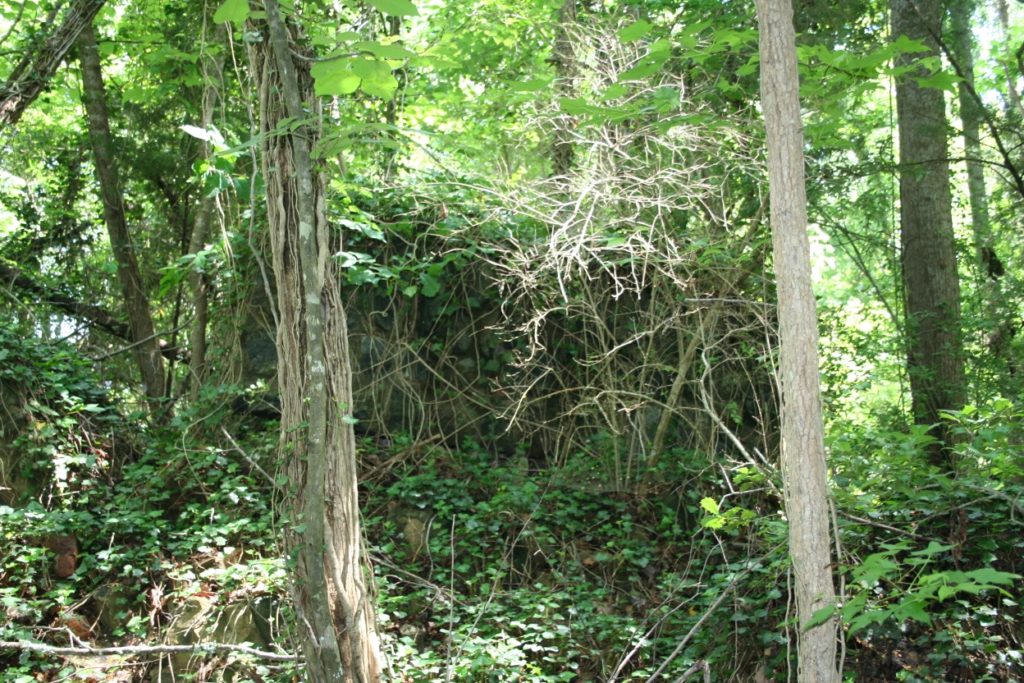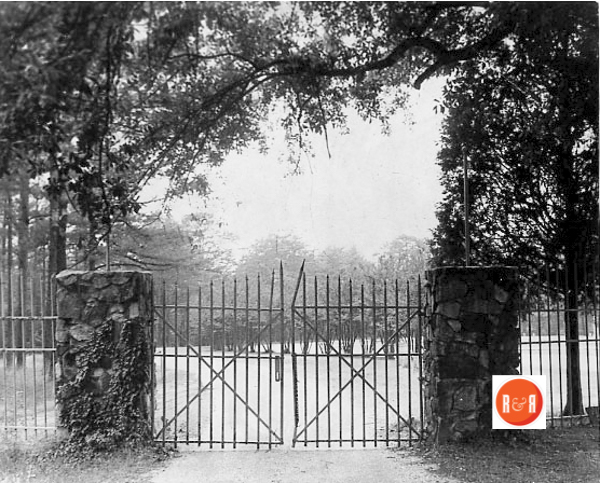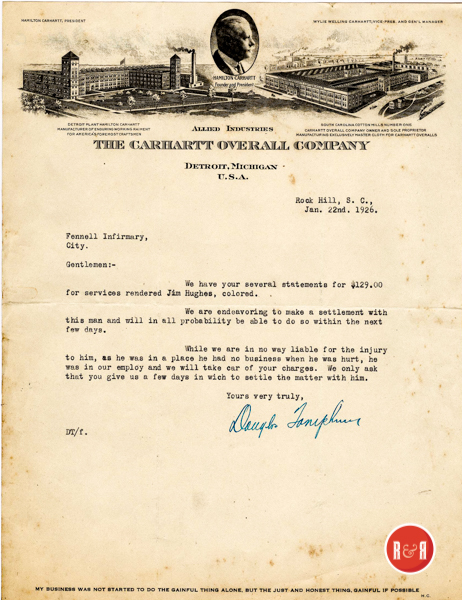“Summer home of Hamilton Carhartt overlooking the Nations Ford Crossing on the Catawba River.”
The Rock Hill Herald reported on March 21, 1916 – “Hamilton Carhartt has had an electric plant installed at his place on the Catawba River at Carhartt’s. The equipment consists of a plant for generating electricity, the power from which is furnished by a gasoline engine. Mr. Carhartt’s house and all those at his place have been wired for lighting, the work being done by the Electrical Supply Co., of Rock Hill.”
City Directories and History: Hamilton Carhartt was born in 1855 in Macedon Lock, New York and he grew up in Southern Michigan. His initial success came from his establishment of a furnishing business, which created in him a desire to create his own products. After talking with a railroad engineer, he realized there was a niche in the market for tough, high quality work wear, so his first product was a heavy-duty overall garment made specifically for railroad workers. Carhartt started out with just four sewing machines and about five employees, and they manufactured their first products out of duck and denim fabrics. His timing was good, as the nation was 


Images of the Carhartt Mansion remains in ca. 2015
experiencing an industrial boom, and in 1889 he founded Carhartt, Inc. in Dearborn, Michigan. In order to establish himself and his company, Hamilton Carhartt personally traveled from town to town, being sure to visit railroad yards and making an impression wherever he traveled. – (http://detroithistorical.org/learn/encyclopedia-of-detroit/carhartt-hamilton)
The Great Depression hit Carhartt as hard as any other business, and only three plants remained in the United States after 1930. To combat this, Hamilton, with the help of his son Wylie, established the “Back to the Land” campaign, creating more of a stronghold than ever with farm and ranch workers.
the company grew throughout the early 1900’s establishing more than 17 plants and three mills throughout the United States, Canada, and Europe. “From the mill to millions” was our motto and was reflected in our operations which included cotton production, denim mills and apparel manufacturing facilities. Carhartt Master Cloth was designed and woven especially by our mills for use in Carhartt garments and was pledged to be the best cloth that could be produced.
Hamilton Carhartt passed away in 1937 at the age of 82. Today, his company remains a family owned operation committed to the mission of providing Best-in-Class apparel for the active worker.

Carhartt Mansion image courtesy of Larry Carhartt via WU Pettus Archives, 2024
“I believe that when a man wears an article that I manufacture, his self-respect is increased because he knows that it is made by an honest manufacturer, who is honest with his employees.”
Hamilton Carhartt
The Yorkville Enquirer reported on Feb. 10, 1892 – “John Morrison, (white), shot and killed Horace White (colored), on the farm of L.D. Childs about seven miles from Rock Hill. Morrison came to Rock Hill to give himself up. The two men had argued over cattle being loose.” *** Note H. Carhartt later purchased the Childs farm of 200 acres….)
The Herald reported on Dec. 13, 1902 – “The Jones Roller Mill, on the river, will grind your corn on Tuesdays and Fridays.”
Courtesy of the WU Pettus Archives – 2024
From the Fort Mill Times, January 30, 1908: Mr. Hamilton Carhartt bought the Whitner farm on the Catawba River some time ago. He has now bought the Jones roller mill property on the river for a price near $10,000. “Mr. Carhartt will in the near future install electric generators in the mill of sufficient power to light that building and his handsome summer home on the Whitner place about a half-mile down the river.”
The Rock Hill Record reported Aug 10, 1908 – “Quiet a number of families from the city have been spending a very pleasant time on the Island at the Carthartt Farm on the Catawba River.”
From the Yorkville Enquirer, August 24, 1909: Mr. Carhartt will give a picnic and barbeque for his employees and their families at the bungalow on the Catawba River.
From the Fort Mill Times, February 23, 1911: Mr. Hamilton Carhartt has purchased 513 acres of farmland from the White family near Carhartt Station between Rock Hill and Fort Mill.
From the Fort Mill Times, February 29, 1912: Mr. Hamilton Carhartt has built a handsome residence on his farm overlooking the Catawba River.
From the Fort Mill Times, May 30, 1912: Mr. Hamilton Carhartt has bought 200 acres of the Childs Tract along the Southern Railroad near the Catawba River bridge. This brings his total holdings in that areas to something like 1,200 acres.
From the Fort Mill Times, January 6, 1916: The Rock Hill Record reports that a booklet has been printed entitled “Hamilton Carhartt Plantation” describing his property on the Catawba River. Mr. R. S. Poag is the capable superintendent. The plantation covers 1,200 acres and grows alfalfa, corn, and cotton. He breeds Arabian horses, polo and Shetland ponies, Berkshire hogs, Shropshire sheep, Guernsey cattle, Hereford beef, White Wyandotte and Rhode Island Red poultry, Japanese silkies for pheasant egg hatching, pheasants, Cameaux pigeons, Belgian hares, Angora goats, and imported white and domestic pea fowls. Mr. Carhartt’s organization has factories in the United States at Dallas, Atlanta, Detroit, and Rock Hill as well as factories in Liverpool, England, Vancouver and Toronto, Canada, and a warehouse in Winnipeg, Canada. Later on Feb. 8, 1916 the Herald reported: “Wylie W. Carhartt, of Detroit, is visiting his family who are wintering at their lodge on the river.”
From the Fort Mill Times, August 10, 1916: The Rock Hill Record reports that Hamilton Carhartt plans to erect a cotton mill at Carhartt Station, three miles south of Fort Mill. Mr. N. G. Walker, architect of Rock Hill is preparing the plans. The building will be three stories with a dye house, boiler rooms, and two warehouses. The village will contain 30 houses arranged in a circular design with a community house in the center. Mr. L. A. Pope of Rock Hill has the contract for the first two houses for workers. All the houses in the village will be of individual design and have pebble dash outside.
The RH Herald reported on June 21, 1941 – “A large barn on the Weil Farm, the old Carhartt Place on the Catawba River, was destroyed by fire last night. Manager, Bob Oats stated today, they lost 400 bushels of oats, 75 bushels of wheat and five tons of hay.”
CARHARTT—HAPPY AND CONTENTED VILLAGE – Contributed by Paul Gettys
This thriving village is the scene of great daily activity and there is in the making a city at no far distant date, if one judges from the indications seen on every hand. One only needs to picture paved streets, the avenue already having been graded and curbed, to give one the prettiest little village to be seen anywhere. The mill here is operating to capacity and there are scores of happy homes, housing several hundred contented and industrious people. One great need felt by the residents is that of an adequate passenger station as they frequently desire to come to Rock Hill. The lonely little shed, that has for years served to protect one from the rain, while waiting for a train, is manfully doing duty at the same old stand, but in rainy weather the conditions are most disagreeable and there is no protection from the cold. It is to be hoped that the proper officials will at an early date take steps to see that a station with telegraphic communication is erected here.

Map of the Nations Ford and area including the Hutchison farmstead. Courtesy of the ENLARGEABLE Heritage Map Collection by Mayhugh – 2017
D. E. Mahaffey is superintendent of the mill and that he is right on the job is evident, after a trip through the big mill. And he has gathered together an array of assistants, as follows: C. W. Ross, overseer of carding; W. S. Parker, overseer of weave room, with J. W. Davis, second hand; W. F. Morton, overseer of spinning; C. A. Moss, machinist; RR. Fry, overseer cloth room; J. R. Huddleston, overseer dye room. Mr. Green is head bookkeeper and postmaster.
A small company store is being operated for the convenience of the people here and a new store is being built. W. M. Lybrand is manager of the store, with Miss Cora Nicholson as assistant. A splendid school is already in operation, with Miss Carrie Bell Poag as principal and Miss Nell Wood assistant teacher. There has been an average attendance of 45 this year and when the new school building, now nearing completion, is ready for occupancy the school facilities will be greatly increased.
Many new residences are going up on the village streets and the ring of the hammer and buzz of the saw can be heard from morn until night. Plans are also about ready for a large and commodious boarding house and this will be another needed convenience.
Those who know Hamilton Carhartt are convinced that he will not stop short of one of the most modern villages to be found anywhere. The site is most ideal and right in the heart of huge cotton fields, just off the banks of the Catawba, where in years gone by the happy Catawbas fished and hunted, a model building has arisen and is steadily being added to. The growth of this village will doubtless prove little short of a revelation to many in Rock Hill and all are cordially invited to come out and get acquainted with their busy and prosperous neighbor.
Every Friday night a social is enjoyed by the villagers and these gatherings are proving a means of getting every person in the village acquainted. Last night the “party” was at the home of Rev. S. W. Whiteside and he occasion was for the benefit of the church and Sunday School. There were numerous boxes to be auctioned off and the proceeds amounted to $11, one of the boxes bringing in the neat sum of $4. Following the sale he boxes were opened.
(Information courtesy of and from: YCGHS – The Quarterly Magazine)
Stay Connected
Explore history, houses, and stories across S.C. Your membership provides you with updates on regional topics, information on historic research, preservation, and monthly feature articles. But remember R&R wants to hear from you and assist in preserving your own family genealogy and memorabilia.
Visit the Southern Queries – Forum to receive assistance in answering questions, discuss genealogy, and enjoy exploring preservation topics with other members. Also listed are several history and genealogical researchers for hire.
User comments welcome — post at the bottom of this page.
Please enjoy this structure and all those listed in Roots and Recall. But remember each is private property. So view them from a distance or from a public area such as the sidewalk or public road.
Do you have information to share and preserve? Family, school, church, or other older photos and stories are welcome. Send them digitally through the “Share Your Story” link, so they too might be posted on Roots and Recall.
Thanks!
User comments always welcome - please post at the bottom of this page.











Share Your Comments & Feedback: